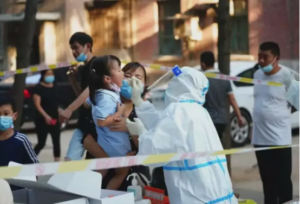
Zhong Nanshan and many other academicians call for: this winter to be vigilant of influenza and new coronavirus superimposed epidemic

“The world still faces the risk of a superimposed epidemic of the new crown pneumonia epidemic and the influenza epidemic, especially this winter.” On November 1, Zhong Nanshan, an academician of the Chinese Academy of Engineering, said at a scientific and academic conference on World Influenza Day 2022 that there is still a need to strengthen the scientific aspects of influenza prevention and control during the new pneumoconiosis epidemic.
Dong Chen, an academician of the Chinese Academy of Sciences, also said that the world is still facing a high risk of overlapping epidemics of respiratory infectious diseases such as influenza and Newcastle pneumonia, and that there is a long way to go in the prevention and control of respiratory infectious diseases.
“Since June this year, there has been a new round of interfowl influenza epidemic in Europe, while the United States has also seen an unprecedented outbreak of avian infection H5N1, there is a very high risk of spillover and infect people. So the superposition of influenza and new coronaviruses is a very big challenge we face this winter and next spring.” Gao Fu, a member of the Chinese Academy of Sciences, pointed out that the current level of vaccination against the new crown is gradually increasing, but the influenza vaccination rate is generally low.
Several experts at the meeting reminded that extra attention should be paid to this winter’s respiratory infectious disease outbreak. So, why is there a high possibility of virus superimposed epidemic this winter? How are we going to deal with this situation?

Influenza epidemic has a “rising” trend
Surveillance data from the past two years show that the prevalence of influenza has been low due to the implementation of measures to prevent and control the new pneumonia epidemic. But the situation is gradually changing.
“The global intensity of influenza has changed in recent times.” Zhang Wenqing, head of the World Health Organization’s Global Influenza Programme, said that at the beginning of the new crown epidemic, influenza prevalence was at a very weak state worldwide, but the change occurred in the second half of 2021, when surveillance showed an increase in the activity of influenza viruses, both in the northern and southern hemispheres, in many countries.
The bigger change comes in the winter of 2022 in the Southern Hemisphere. “In some countries in the Southern Hemisphere, influenza virus activity is more intense than it was before the New Coronavirus outbreak.” Zhang Wenqing said this signals an important question about whether there will be a seasonal peak of influenza affected by the New Crown pneumonia epidemic in the following Northern Hemisphere influenza season, as there will be in the Southern Hemisphere.
Talking about the reasons for such a change, Gough said one of the possible reasons is that public health measures have been implemented globally for the past three years and the overall population is less immune to influenza viruses, while some countries have recently relaxed their public health policies, a situation where new subtypes of influenza viruses are more likely to emerge. At the same time, the low rate of influenza vaccination has also contributed to a situation where influenza viruses are more likely to be prevalent.

Respiratory viruses should be the focus of infectious disease prevention and control
“New coronaviruses and influenza viruses are respiratory viruses, respiratory viral infections tend to have a short incubation period, spread rapidly, spread more widely, are highly transmissible, have a high incidence and are more difficult to control.” Zhong Nanshan pointed out that outbreaks caused by respiratory viruses often lead to serious public health events once they occur, which in turn becomes the focus of prevention and control among infectious diseases worldwide.
How to effectively respond to the possible arrival of a superimposed epidemic of influenza and new coronaviruses?
Zhong Nanshan believes that basic and clinical research has important scientific and practical significance in the diagnosis and control of respiratory viruses. In the New Coronavirus epidemic, basic research on pathogenesis has been promoted, and the development of rapid clinical diagnostic tools has been accelerated, providing an important basis for the practice of prevention and control of clinical epidemics and the judgment of disease prognosis.
Scholars from different regions, such as Russia and the United Kingdom, agreed that the experience during the New Coronary Pneumonia epidemic is worth learning from, for example, the development of rapid and accessible diagnostic tools may play a crucial role in the prevention and control of influenza epidemics.
It is also worth learning from the relevant research results achieved during the Newcastle pneumonia epidemic –
“In recent years, China has achieved a landmark series of results in respiratory virus research.” Dong Chen said basic research has made progress in respiratory viruses, pathogenesis, structural biology, immunology, cross-species transmission and pathogenesis of infection, clinical treatment, vaccine drugs and antibodies, forming a better technical reserve that can provide guidance for the prevention and control strategy of influenza.


Average Rating